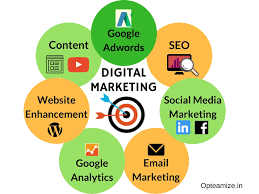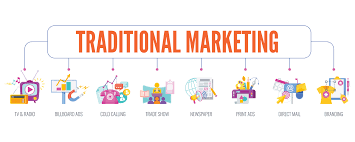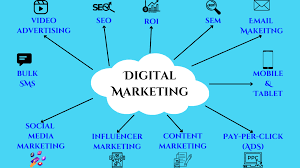
Digital versus traditional marketing
In today’s fast-paced world, digital versus traditional marketing presents a key choice for businesses. Knowing their differences helps determine which strategy best fits your brand, audience, and marketing goals.
What is Traditional Marketing?
Traditional marketing refers to conventional methods used for decades to reach consumers. These include:
Print Ads (newspapers, magazines)
TV and Radio Commercials
Billboards and Posters
Direct Mail (flyers, postcards)
Telemarketing
These methods rely heavily on physical or broadcast media to reach a broader audience, often in a local or regional market.

What is Digital Marketing?
Digital marketing taps into web-based platforms and tech to engage target consumers. Common methods include:”
Search Engine Optimization (SEO)
Social Media Marketing (Facebook, Instagram, LinkedIn)
Email Campaigns
Pay-Per-Click (PPC) Ads
Content Marketing and Blogging
Influencer Collaborations
It’s a more interactive, data-driven approach, enabling real-time communication and measurable results.
Key Differences Between Digital and Traditional Marketing
Feature Traditional Marketing Digital Marketing
Medium Print, TV, radio, billboards Online platforms (web, apps, social)
Audience Reach Local/National Global
Cost Often expensive (TV ads, print) More cost-effective (ads, SEO)
Tracking Difficult to measure Real-time analytics available
Interactivity One-way communication Two-way, interactive
Customization Generic messages Highly targeted content
Time to Launch Longer lead time Can be instant

Pros and Cons of digital versus traditional marketing
https://tedigitalmarketing.com/digital-marketing/pros-and-cons-of-traditional-marketing-and-digital-marketing/
Traditional Marketing Pros:
Tangible materials leave a lasting impression
Great for local brand awareness
More trusted among older demographics

Traditional Marketing Cons:
Expensive and harder to track ROI
Limited audience targeting
Static content with no real-time updates
Digital Marketing Pros:
Cost-effective with higher ROI potential
Detailed targeting and segmentation
Instant feedback and measurable results
Ideal for mobile and tech-savvy users

Digital Marketing Cons:
Can be overlooked amid the constant stream of digital content.”
Requires tech skills and constant updates
Ad fatigue and privacy concerns among users
Which One is Better?
There’s no one-size-fits-all answer. The choice depends on:
Your Target Audience: Younger audiences lean digital; older generations may prefer traditional.
Your Budget: Small businesses may find digital more affordable.
Your Business Goals: Want local exposure? Traditional may help. Looking for global reach? Go digital.
Key Differences Between Digital versus Traditional Marketing
| Feature | Traditional Marketing | Digital Marketing |
|---|---|---|
| Platform | Offline (TV, radio, print) | Online (websites, social media, apps) |
| Audience Targeting | Broad, demographic-based | Narrow, behavior and interest-based |
| Interaction | One-way communication | Two-way, interactive |
| Measurability | Limited tracking | Fully trackable in real-time |
| Cost | High, especially for TV and print ads | Lower, scalable based on budget |
| Reach | Local or national | Global |
| Campaign Speed | Longer setup, less flexible | Can launch and adjust instantly |
| Content Format | Static (posters, mailers) | Dynamic (videos, polls, stories, etc.) |
Which Marketing Strategy Should You Choose?
Choosing between digital and traditional marketing depends on several factors:
🎯 Know Your Audience
- If you’re targeting older generations who read newspapers or watch TV, traditional marketing might work better.
- If your audience is younger and spends time on Instagram or YouTube, digital is the way to go.
💰 Consider Your Budget
- Startups and small businesses may not afford TV commercials or magazine ads.
- Digital marketing allows for flexible spending and lower entry costs.
📊 Measure Your Results
- Do you need to see how many people saw, clicked, or bought from your ad? Digital marketing wins here.
- Traditional methods offer limited feedback and rely more on estimation than data.
🔄 Flexibility Matters
- Digital campaigns can be updated instantly. If an ad isn’t performing, you can pause, edit, or retarget.
- Traditional campaigns are fixed once published or aired.
Integrated Marketing: Best of Both Worlds
Many successful brands today use a hybrid strategy—combining both digital and traditional methods to maximize impact. For example:
- A car dealership may run a TV commercial to build awareness and drive people to their website, where they find more offers and book test drives.
- A retail brand may place billboards around the city and simultaneously run Instagram ads for time-limited sales.
This integrated approach ensures that the business is visible across multiple touchpoints, increasing chances of conversion and brand recall.
Conclusion of digital versus traditional marketing
Both digital and traditional marketing have their advantages. The key is to understand your goals, audience, and resources before deciding on the right approach. In today’s digital-first world, most businesses benefit from having a strong digital presence—but traditional methods still offer value when used strategically.
By combining the credibility of traditional media with the precision of digital platforms, businesses can craft campaigns that are powerful, effective, and relevant in today’s changing market.
here for contact us
